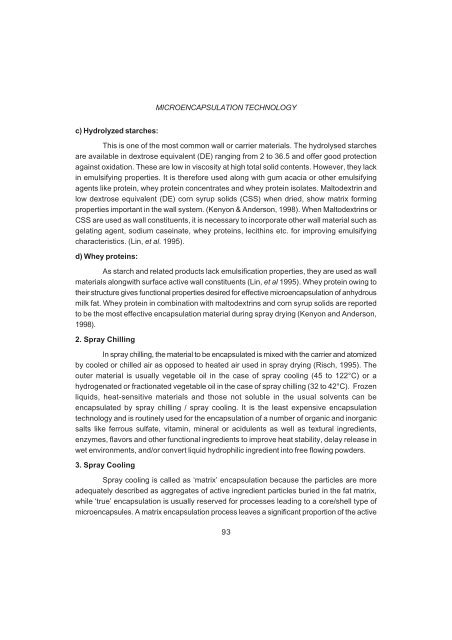Download (60Kb)
Download (60Kb)
Download (60Kb)
You also want an ePaper? Increase the reach of your titles
YUMPU automatically turns print PDFs into web optimized ePapers that Google loves.
c) Hydrolyzed starches:<br />
This is one of the most common wall or carrier materials. The hydrolysed starches<br />
are available in dextrose equivalent (DE) ranging from 2 to 36.5 and offer good protection<br />
against oxidation. These are low in viscosity at high total solid contents. However, they lack<br />
in emulsifying properties. It is therefore used along with gum acacia or other emulsifying<br />
agents like protein, whey protein concentrates and whey protein isolates. Maltodextrin and<br />
low dextrose equivalent (DE) corn syrup solids (CSS) when dried, show matrix forming<br />
properties important in the wall system. (Kenyon & Anderson, 1998). When Maltodextrins or<br />
CSS are used as wall constituents, it is necessary to incorporate other wall material such as<br />
gelating agent, sodium caseinate, whey proteins, lecithins etc. for improving emulsifying<br />
characteristics. (Lin, et al. 1995).<br />
d) Whey proteins:<br />
As starch and related products lack emulsification properties, they are used as wall<br />
materials alongwith surface active wall constituents (Lin, et al 1995). Whey protein owing to<br />
their structure gives functional properties desired for effective microencapsulation of anhydrous<br />
milk fat. Whey protein in combination with maltodextrins and corn syrup solids are reported<br />
to be the most effective encapsulation material during spray drying (Kenyon and Anderson,<br />
1998).<br />
2. Spray Chilling<br />
In spray chilling, the material to be encapsulated is mixed with the carrier and atomized<br />
by cooled or chilled air as opposed to heated air used in spray drying (Risch, 1995). The<br />
outer material is usually vegetable oil in the case of spray cooling (45 to 122°C) or a<br />
hydrogenated or fractionated vegetable oil in the case of spray chilling (32 to 42°C). Frozen<br />
liquids, heat-sensitive materials and those not soluble in the usual solvents can be<br />
encapsulated by spray chilling / spray cooling. It is the least expensive encapsulation<br />
technology and is routinely used for the encapsulation of a number of organic and inorganic<br />
salts like ferrous sulfate, vitamin, mineral or acidulents as well as textural ingredients,<br />
enzymes, flavors and other functional ingredients to improve heat stability, delay release in<br />
wet environments, and/or convert liquid hydrophilic ingredient into free flowing powders.<br />
3. Spray Cooling<br />
MICROENCAPSULATION TECHNOLOGY<br />
Spray cooling is called as ‘matrix’ encapsulation because the particles are more<br />
adequately described as aggregates of active ingredient particles buried in the fat matrix,<br />
while ‘true’ encapsulation is usually reserved for processes leading to a core/shell type of<br />
microencapsules. A matrix encapsulation process leaves a significant proportion of the active<br />
93
















